Vera Schmitt
PolBiX: Detecting LLMs' Political Bias in Fact-Checking through X-phemisms
Sep 18, 2025Abstract:Large Language Models are increasingly used in applications requiring objective assessment, which could be compromised by political bias. Many studies found preferences for left-leaning positions in LLMs, but downstream effects on tasks like fact-checking remain underexplored. In this study, we systematically investigate political bias through exchanging words with euphemisms or dysphemisms in German claims. We construct minimal pairs of factually equivalent claims that differ in political connotation, to assess the consistency of LLMs in classifying them as true or false. We evaluate six LLMs and find that, more than political leaning, the presence of judgmental words significantly influences truthfulness assessment. While a few models show tendencies of political bias, this is not mitigated by explicitly calling for objectivism in prompts.
Multilingual Datasets for Custom Input Extraction and Explanation Requests Parsing in Conversational XAI Systems
Aug 20, 2025Abstract:Conversational explainable artificial intelligence (ConvXAI) systems based on large language models (LLMs) have garnered considerable attention for their ability to enhance user comprehension through dialogue-based explanations. Current ConvXAI systems often are based on intent recognition to accurately identify the user's desired intention and map it to an explainability method. While such methods offer great precision and reliability in discerning users' underlying intentions for English, a significant challenge in the scarcity of training data persists, which impedes multilingual generalization. Besides, the support for free-form custom inputs, which are user-defined data distinct from pre-configured dataset instances, remains largely limited. To bridge these gaps, we first introduce MultiCoXQL, a multilingual extension of the CoXQL dataset spanning five typologically diverse languages, including one low-resource language. Subsequently, we propose a new parsing approach aimed at enhancing multilingual parsing performance, and evaluate three LLMs on MultiCoXQL using various parsing strategies. Furthermore, we present Compass, a new multilingual dataset designed for custom input extraction in ConvXAI systems, encompassing 11 intents across the same five languages as MultiCoXQL. We conduct monolingual, cross-lingual, and multilingual evaluations on Compass, employing three LLMs of varying sizes alongside BERT-type models.
Through a Compressed Lens: Investigating the Impact of Quantization on LLM Explainability and Interpretability
May 20, 2025Abstract:Quantization methods are widely used to accelerate inference and streamline the deployment of large language models (LLMs). While prior research has extensively investigated the degradation of various LLM capabilities due to quantization, its effects on model explainability and interpretability, which are crucial for understanding decision-making processes, remain unexplored. To address this gap, we conduct comprehensive experiments using three common quantization techniques at distinct bit widths, in conjunction with two explainability methods, counterfactual examples and natural language explanations, as well as two interpretability approaches, knowledge memorization analysis and latent multi-hop reasoning analysis. We complement our analysis with a thorough user study, evaluating selected explainability methods. Our findings reveal that, depending on the configuration, quantization can significantly impact model explainability and interpretability. Notably, the direction of this effect is not consistent, as it strongly depends on (1) the quantization method, (2) the explainability or interpretability approach, and (3) the evaluation protocol. In some settings, human evaluation shows that quantization degrades explainability, while in others, it even leads to improvements. Our work serves as a cautionary tale, demonstrating that quantization can unpredictably affect model transparency. This insight has important implications for deploying LLMs in applications where transparency is a critical requirement.
Truth or Twist? Optimal Model Selection for Reliable Label Flipping Evaluation in LLM-based Counterfactuals
May 20, 2025Abstract:Counterfactual examples are widely employed to enhance the performance and robustness of large language models (LLMs) through counterfactual data augmentation (CDA). However, the selection of the judge model used to evaluate label flipping, the primary metric for assessing the validity of generated counterfactuals for CDA, yields inconsistent results. To decipher this, we define four types of relationships between the counterfactual generator and judge models. Through extensive experiments involving two state-of-the-art LLM-based methods, three datasets, five generator models, and 15 judge models, complemented by a user study (n = 90), we demonstrate that judge models with an independent, non-fine-tuned relationship to the generator model provide the most reliable label flipping evaluations. Relationships between the generator and judge models, which are closely aligned with the user study for CDA, result in better model performance and robustness. Nevertheless, we find that the gap between the most effective judge models and the results obtained from the user study remains considerably large. This suggests that a fully automated pipeline for CDA may be inadequate and requires human intervention.
Towards Automated Fact-Checking of Real-World Claims: Exploring Task Formulation and Assessment with LLMs
Feb 13, 2025



Abstract:Fact-checking is necessary to address the increasing volume of misinformation. Traditional fact-checking relies on manual analysis to verify claims, but it is slow and resource-intensive. This study establishes baseline comparisons for Automated Fact-Checking (AFC) using Large Language Models (LLMs) across multiple labeling schemes (binary, three-class, five-class) and extends traditional claim verification by incorporating analysis, verdict classification, and explanation in a structured setup to provide comprehensive justifications for real-world claims. We evaluate Llama-3 models of varying sizes (3B, 8B, 70B) on 17,856 claims collected from PolitiFact (2007-2024) using evidence retrieved via restricted web searches. We utilize TIGERScore as a reference-free evaluation metric to score the justifications. Our results show that larger LLMs consistently outperform smaller LLMs in classification accuracy and justification quality without fine-tuning. We find that smaller LLMs in a one-shot scenario provide comparable task performance to fine-tuned Small Language Models (SLMs) with large context sizes, while larger LLMs consistently surpass them. Evidence integration improves performance across all models, with larger LLMs benefiting most. Distinguishing between nuanced labels remains challenging, emphasizing the need for further exploration of labeling schemes and alignment with evidences. Our findings demonstrate the potential of retrieval-augmented AFC with LLMs.
FitCF: A Framework for Automatic Feature Importance-guided Counterfactual Example Generation
Jan 01, 2025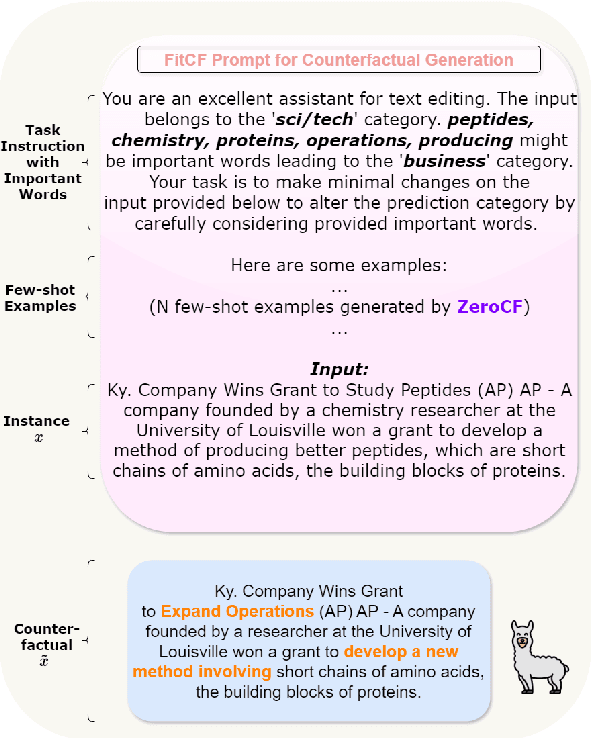
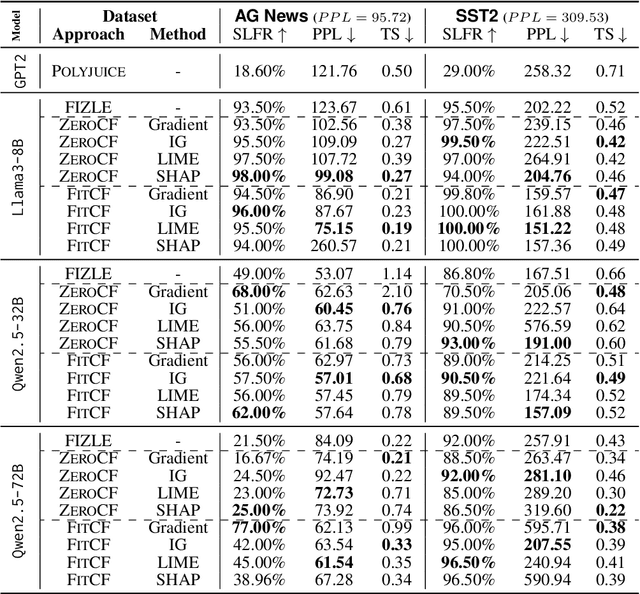
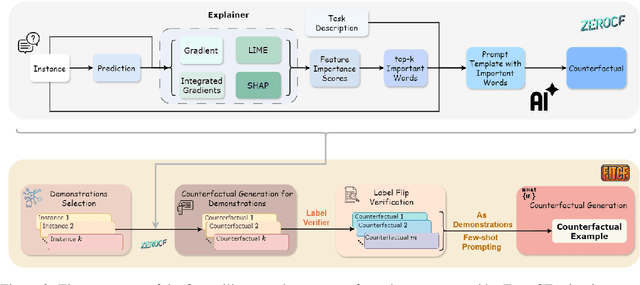
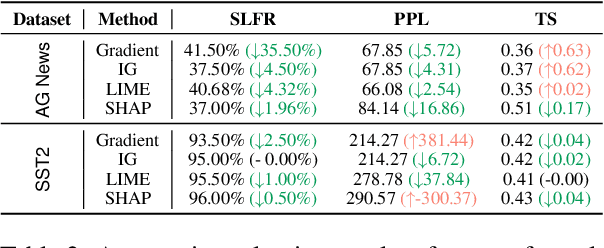
Abstract:Counterfactual examples are widely used in natural language processing (NLP) as valuable data to improve models, and in explainable artificial intelligence (XAI) to understand model behavior. The automated generation of counterfactual examples remains a challenging task even for large language models (LLMs), despite their impressive performance on many tasks. In this paper, we first introduce ZeroCF, a faithful approach for leveraging important words derived from feature attribution methods to generate counterfactual examples in a zero-shot setting. Second, we present a new framework, FitCF, which further verifies aforementioned counterfactuals by label flip verification and then inserts them as demonstrations for few-shot prompting, outperforming two state-of-the-art baselines. Through ablation studies, we identify the importance of each of FitCF's core components in improving the quality of counterfactuals, as assessed through flip rate, perplexity, and similarity measures. Furthermore, we show the effectiveness of LIME and Integrated Gradients as backbone attribution methods for FitCF and find that the number of demonstrations has the largest effect on performance. Finally, we reveal a strong correlation between the faithfulness of feature attribution scores and the quality of generated counterfactuals.
Anchored Alignment for Self-Explanations Enhancement
Oct 17, 2024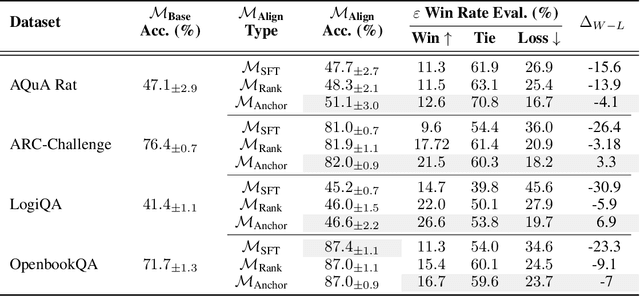
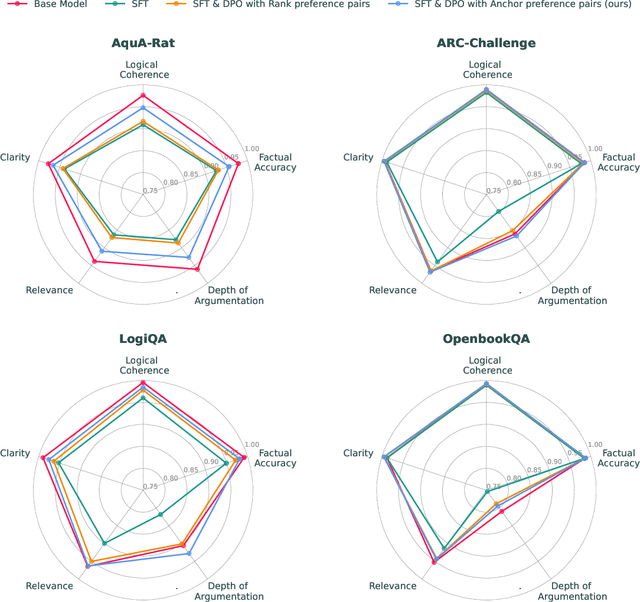
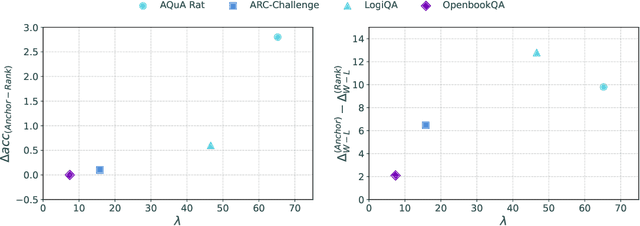
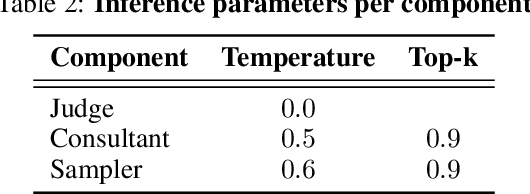
Abstract:In this work, we introduce a methodology for alignment designed to enhance the ability of large language models (LLMs) to articulate their reasoning (self-explanation) even in the absence of annotated rationale explanations. Our alignment methodology comprises three key components: explanation quality assessment, self-instruction dataset generation, and model alignment. Additionally, we present a novel technique called Alignment with Anchor Preference Pairs, which improves the selection of preference pairs by categorizing model outputs into three groups: consistently correct, consistently incorrect, and variable. By applying tailored strategies to each category, we enhance the effectiveness of Direct Preference Optimization (DPO). Our experimental results demonstrate that this approach significantly improves explanation quality while maintaining accuracy compared to other fine-tuning strategies.
Cross-Refine: Improving Natural Language Explanation Generation by Learning in Tandem
Sep 11, 2024Abstract:Natural language explanations (NLEs) are vital for elucidating the reasoning behind large language model (LLM) decisions. Many techniques have been developed to generate NLEs using LLMs. However, like humans, LLMs might not always produce optimal NLEs on first attempt. Inspired by human learning processes, we introduce Cross-Refine, which employs role modeling by deploying two LLMs as generator and critic, respectively. The generator outputs a first NLE and then refines this initial explanation using feedback and suggestions provided by the critic. Cross-Refine does not require any supervised training data or additional training. We validate Cross-Refine across three NLP tasks using three state-of-the-art open-source LLMs through automatic and human evaluation. We select Self-Refine (Madaan et al., 2023) as the baseline, which only utilizes self-feedback to refine the explanations. Our findings from automatic evaluation and a user study indicate that Cross-Refine outperforms Self-Refine. Meanwhile, Cross-Refine can perform effectively with less powerful LLMs, whereas Self-Refine only yields strong results with ChatGPT. Additionally, we conduct an ablation study to assess the importance of feedback and suggestions. Both of them play an important role in refining explanations. We further evaluate Cross-Refine on a bilingual dataset in English and German.
Protect and Extend -- Using GANs for Synthetic Data Generation of Time-Series Medical Records
Mar 01, 2024Abstract:Preservation of private user data is of paramount importance for high Quality of Experience (QoE) and acceptability, particularly with services treating sensitive data, such as IT-based health services. Whereas anonymization techniques were shown to be prone to data re-identification, synthetic data generation has gradually replaced anonymization since it is relatively less time and resource-consuming and more robust to data leakage. Generative Adversarial Networks (GANs) have been used for generating synthetic datasets, especially GAN frameworks adhering to the differential privacy phenomena. This research compares state-of-the-art GAN-based models for synthetic data generation to generate time-series synthetic medical records of dementia patients which can be distributed without privacy concerns. Predictive modeling, autocorrelation, and distribution analysis are used to assess the Quality of Generating (QoG) of the generated data. The privacy preservation of the respective models is assessed by applying membership inference attacks to determine potential data leakage risks. Our experiments indicate the superiority of the privacy-preserving GAN (PPGAN) model over other models regarding privacy preservation while maintaining an acceptable level of QoG. The presented results can support better data protection for medical use cases in the future.
A Feature Extraction based Model for Hate Speech Identification
Jan 11, 2022
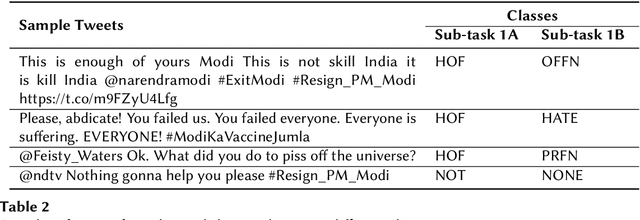
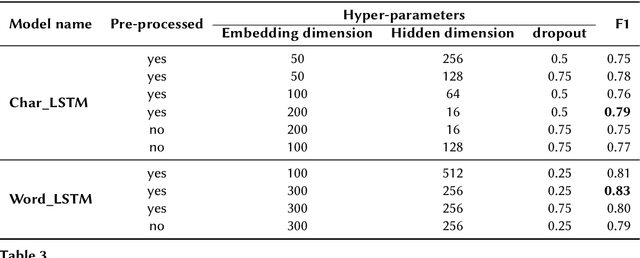

Abstract:The detection of hate speech online has become an important task, as offensive language such as hurtful, obscene and insulting content can harm marginalized people or groups. This paper presents TU Berlin team experiments and results on the task 1A and 1B of the shared task on hate speech and offensive content identification in Indo-European languages 2021. The success of different Natural Language Processing models is evaluated for the respective subtasks throughout the competition. We tested different models based on recurrent neural networks in word and character levels and transfer learning approaches based on Bert on the provided dataset by the competition. Among the tested models that have been used for the experiments, the transfer learning-based models achieved the best results in both subtasks.
 Add to Chrome
Add to Chrome Add to Firefox
Add to Firefox Add to Edge
Add to Edge